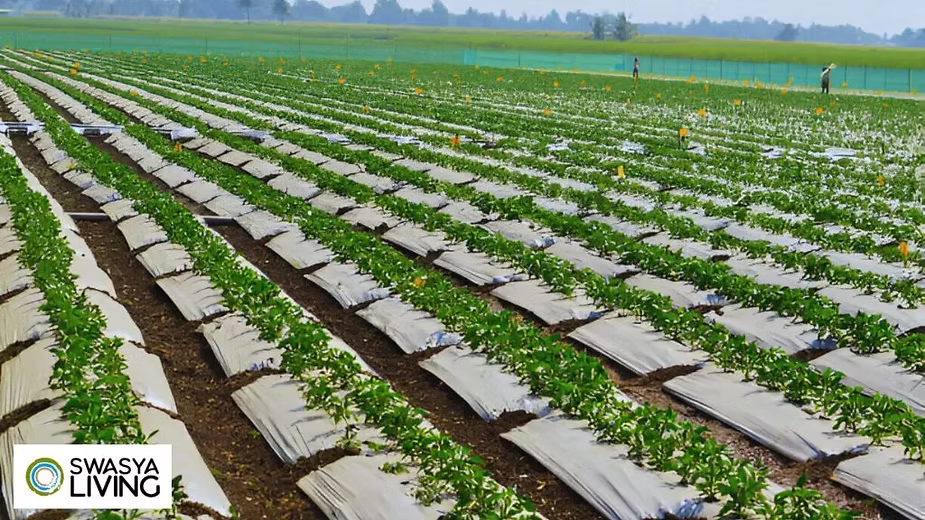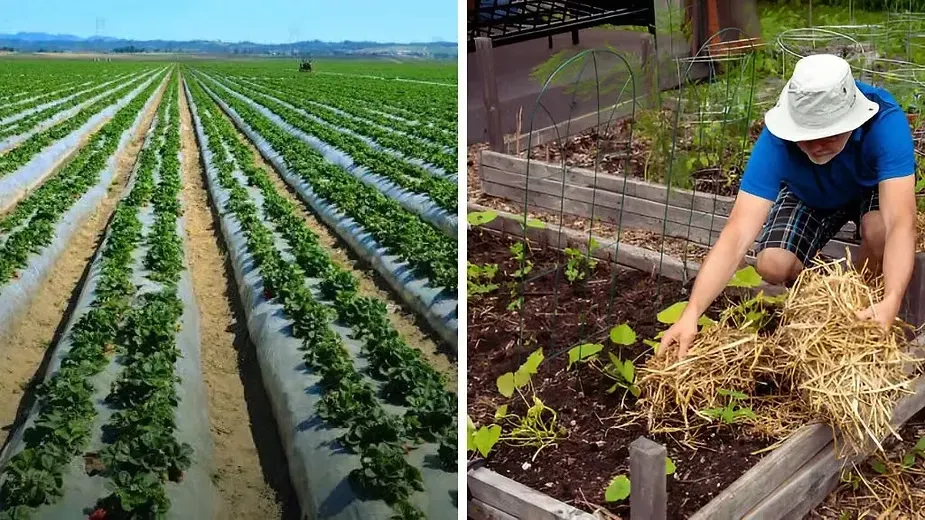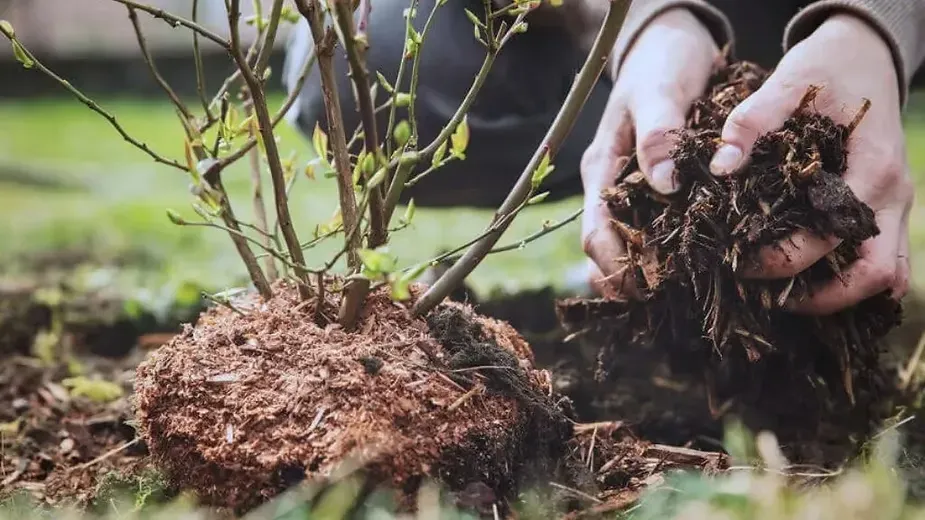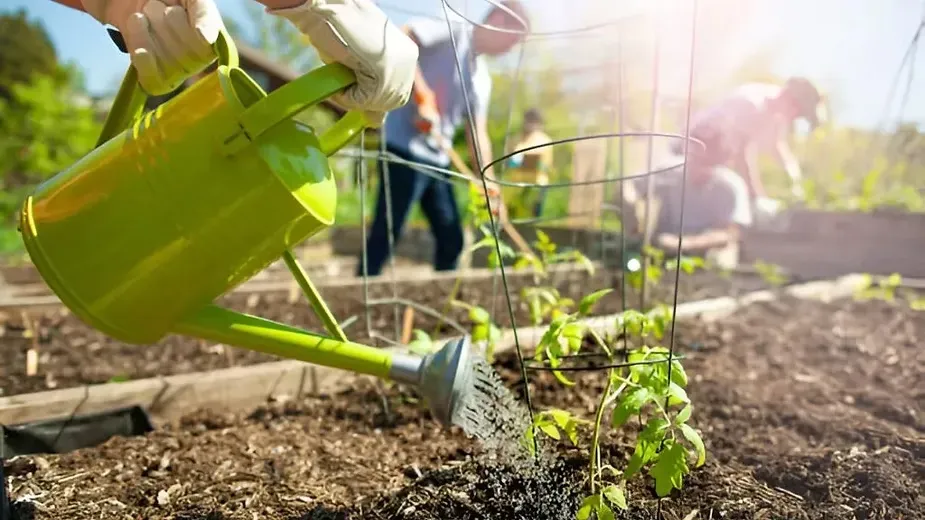What is Mulching in Agriculture? Types, Benefits, Uses!
Published on July 26, 2025

Mulching in agriculture is the practice of covering the soil surface with materials such as straw, compost, wood chips, or plastic to enhance crop growth and maintain soil health. Essentially, mulching involves placing a protective layer over the soil, offering multiple benefits like moisture retention, weed suppression, and temperature regulation, which contribute to sustainable farming.
Mulching can be done in various farming settings, from vegetable gardens and orchards to large-scale field crops. It’s suitable for nearly any type of soil and is adaptable to different climates and farming conditions. Mulching is particularly useful during dry seasons when moisture conservation is critical, but it can also benefit crops during rainy periods by reducing soil erosion and preventing waterlogging.
The timing of mulching depends on the specific needs of your crops. For example, mulching before the onset of summer helps maintain soil moisture and coolness, while mulching before winter insulates plant roots against the cold. Consistently applying mulch throughout the growing season can protect plants from temperature fluctuations and reduce the need for frequent watering and chemical inputs.
In the following sections, we’ll explore the types, benefits, and practical uses of mulching to help you choose the best approach for your agricultural needs.
Understanding Mulching in Agriculture
Mulching farming entails applying a protective layer over the soil, which can be organic or inorganic. This layer serves multiple purposes:
Moisture Conservation: Mulch reduces evaporation, maintaining consistent soil moisture levels.
Weed Control: By blocking sunlight, mulch inhibits weed germination and growth.
Temperature Regulation: Mulch insulates the soil, keeping it cooler in summer and warmer in winter.
Soil Health Improvement: Organic mulches decompose over time, enriching the soil with essential nutrients.
Different Types of Mulching in Agriculture

There are two primary types of mulching in agriculture: organic and inorganic.
1. Organic Mulch: Derived from natural materials, organic mulch includes:
Straw and Hay: Effective for moisture retention and weed suppression.
Compost: Enhances soil fertility as it decomposes.
Wood Chips and Bark: Provide long-term coverage and improve soil structure.
Grass Clippings: Readily available and add nitrogen to the soil as they decompose.
Leaves: Shredded leaves decompose quickly, adding organic matter to the soil.
Peat Moss: Improves soil structure and moisture retention but should be used sparingly due to environmental concerns.
2. Inorganic Mulch: Made from synthetic or non-decomposable materials, inorganic mulch includes:
Plastic Films: Common in vegetable farming for moisture conservation and weed control.
Gravel and Stones: Used in areas requiring permanent coverage and erosion control.
Landscape Fabric: Permeable material that allows water penetration while suppressing weeds.
Rubber Mulch: Made from recycled tires, it is durable and effective for long-term weed control.
Geotextiles: Synthetic fabrics used for soil stabilization and erosion control.
How to Choose Mulch Material?
Selecting the right mulch material is essential to gain the full benefits of mulching farming. Here’s a breakdown of important factors to consider when choosing mulch material for agricultural purposes.
1. Thickness:
The thickness of mulch is usually less critical, except in cases where solarisation, or soil heating, is required. For artificial mulch films, thickness becomes more relevant based on crop type and duration. Vegetable crops, for instance, generally benefit from films that are 15-30 microns thick, while orchids may require thicker films ranging from 100-150 microns. For crops with shorter growth cycles, a 25-micron film often provides adequate coverage and durability.
2. Width:
Width is another important factor, particularly to match the inter-row spacing of crops. Ensuring that the mulch film aligns with plant spacing helps maximize coverage and efficiency. In general conditions, a mulch width of around 1 to 1.5 meters is commonly suitable for effective coverage and ease of application.
3. Colour:
The colour of mulch affects much more than just aesthetics. Black plastic mulch, for example, is widely used to suppress weeds and retain soil warmth, making it ideal for cool-season crops. White or reflective mulches, on the other hand, can help lower soil temperatures in hotter climates, providing a cooling effect. Colour can also influence air temperature around plants, soil salinity, and even pest incidence, making it a critical choice based on climate and crop needs.
4. Perforation:
Perforation in mulch films helps determine water and nutrient distribution. If you aim to deliver water and fertilisers evenly across the crop, unperforated mulch is the best option, ensuring nutrients remain concentrated around plant roots. However, perforated mulch allows better water drainage and prevents stagnation around plants. Keep in mind that perforated mulch can sometimes encourage weed growth, so it’s best used in cases where water management is a primary concern.
What are the Techniques Used in Mulching ?

Here’s an overview of popular mulching techniques used in agriculture:
1. Broadcast Mulching
Description: This is a simple and widely used technique where mulch is spread over the soil surface by hand or machine.
Materials: Typically, organic materials like straw, leaves, grass clippings, or compost are used.
Applications: Broadcast mulching is ideal for row crops, orchards, and vegetable gardens, offering broad coverage and easy application.
2. Sheet Mulching
Description: This technique involves layering different materials directly on the soil in a manner similar to composting. Typically, cardboard or newspaper is placed at the bottom to suppress weeds, followed by organic materials like compost, straw, or grass clippings.
Benefits: Sheet mulching improves soil structure and fertility over time as the layers decompose.
Applications: Commonly used in no-till gardening and permaculture to enrich soil naturally.
3. Plastic Mulching
Description: In this technique, sheets of plastic (usually black or clear) are laid directly over the soil. Holes are cut in the plastic to plant crops.
Benefits: Plastic mulch conserves soil moisture, suppresses weeds, and can increase soil temperature, which benefits crops that require warmer soil, such as tomatoes and melons.
Applications: Widely used in vegetable farming and fruit production, especially for crops that need precise moisture control.
4. Living Mulch
Description: Living mulch involves growing cover crops or low-growing plants around primary crops. These plants act as mulch by shading the soil and conserving moisture.
Benefits: Living mulch prevents soil erosion, enhances biodiversity, and can naturally fix nitrogen in the soil if legumes are used.
Applications: Often used in orchards, vineyards, and between rows of vegetable crops.
5. Straw or Hay Mulching
Description: Straw or hay is laid around plants and over bare soil to protect against moisture loss and weeds.
Benefits: Straw mulch is affordable, readily available, and breaks down over time, enriching the soil.
Applications: This method is popular in vegetable gardens and for crops like strawberries, potatoes, and beans.
6. Gravel or Rock Mulching
Description: Gravel or small stones are spread over the soil surface to provide long-term coverage.
Benefits: Gravel mulch is durable, doesn’t decompose, and is effective for controlling weeds and preventing soil erosion. It also keeps the soil cooler in hot climates.
Applications: Often used in landscaping, ornamental gardens, or areas where permanent mulch is preferred.
7. Compost Mulching
Description: Compost is spread over the soil as a nutrient-rich mulch that also improves soil structure.
Benefits: Compost mulch gradually releases nutrients into the soil, supporting plant growth and improving microbial activity.
Applications: Useful in vegetable beds, flower beds, and around fruit trees to boost soil fertility.
8. Seasonal Mulching
Description: Seasonal mulching adjusts based on climate needs. For example, thicker mulches are applied before winter to insulate soil and roots, while lighter mulches are used in warmer months.
Benefits: This technique offers flexibility in protecting plants from extreme weather while maintaining soil health.
Applications: Especially useful in regions with distinct seasonal changes, applied in orchards, perennial beds, and around shrubs.
Mulching in Agriculture: What is it used for?

Mulching is versatile and applicable in various agricultural settings:
Vegetable Gardens: Plastic mulches are commonly used to conserve moisture and control weeds.
Fruit Plantations: Organic mulches, such as compost or coconut husk, are often used in fruit plantations. They help retain soil moisture, prevent soil compaction, and keep the root zone cool, promoting better fruit production.
Vineyards: In vineyards, mulch suppresses weeds and maintains soil structure, which is crucial for grapevines that are sensitive to soil moisture fluctuations. Mulching also reduces water requirements, especially in drier climates.
Herb and Medicinal Plant Gardens: Organic mulches like straw or grass clippings are popular in herb gardens, as they decompose to provide nutrients, helping maintain the delicate balance required for herbs and medicinal plants.
Greenhouses and Polyhouses: Mulching in controlled environments helps regulate soil temperature, reduce water evaporation, and prevent weed growth. Inorganic mulches like black plastic or landscape fabric are commonly used in these settings for effective results.
Flower Beds and Ornamental Planting: Mulching around flowers and ornamental plants helps maintain a stable soil environment, which is essential for aesthetic gardening. Organic mulches, such as bark or wood chips, are preferred as they add a decorative touch while promoting soil health.
Terrace Farming and Small Plot Gardens: In urban settings or terrace gardens, mulching is essential to retain moisture in smaller, exposed soil patches. It reduces watering needs and protects plants from extreme temperature changes often seen on terraces or rooftops.
Rice Paddy Fields: In areas where rice is grown, mulching with straw helps control weeds, prevent nutrient loss, and retain water in fields. This practice is especially beneficial in areas with limited water resources.
Advantages and Disadvantages of Mulching
Here's a table of advantages and disadvantages of mulching:
Advantages | Description |
Moisture Retention | Reduces evaporation, keeping soil moisture stable and lowering irrigation needs. |
Weed Suppression | Blocks sunlight, preventing weed growth and reducing labor and herbicide use. |
Temperature Regulation | Keeps soil cooler in summer and warmer in winter, protecting roots from extreme conditions. |
Less Chemical Use | Naturally suppresses weeds and some pests, reducing the need for herbicides and pesticides. |
Disadvantages | Description |
Initial Cost and Labor | Mulching materials can be costly and require significant labor for application and maintenance. |
Attracts Some Pests | Moist environments under mulch can attract slugs, snails, and rodents. |
Potential Nutrient Imbalance | Wood-based mulches can temporarily reduce nitrogen availability in the soil. |
Risk of Waterlogging | Can trap excess moisture in rainy areas, leading to root rot. |
Conclusion
Mulching in agriculture is a valuable practice that boosts soil health, conserves moisture, and enhances crop productivity, making it a key component of sustainable farming. By selecting the right type of mulch—organic or inorganic—farmers can cater to their specific crop needs and environmental conditions, reaping benefits such as weed control, temperature regulation, and reduced water usage.
However, careful consideration of mulch thickness, width, colour, and perforation is essential to avoid challenges like pest attraction and nutrient imbalances. With the right approach, mulching can be effectively applied across various agricultural settings, from vegetable gardens to orchards, to foster healthier, more resilient crops and support long-term agricultural sustainability.
